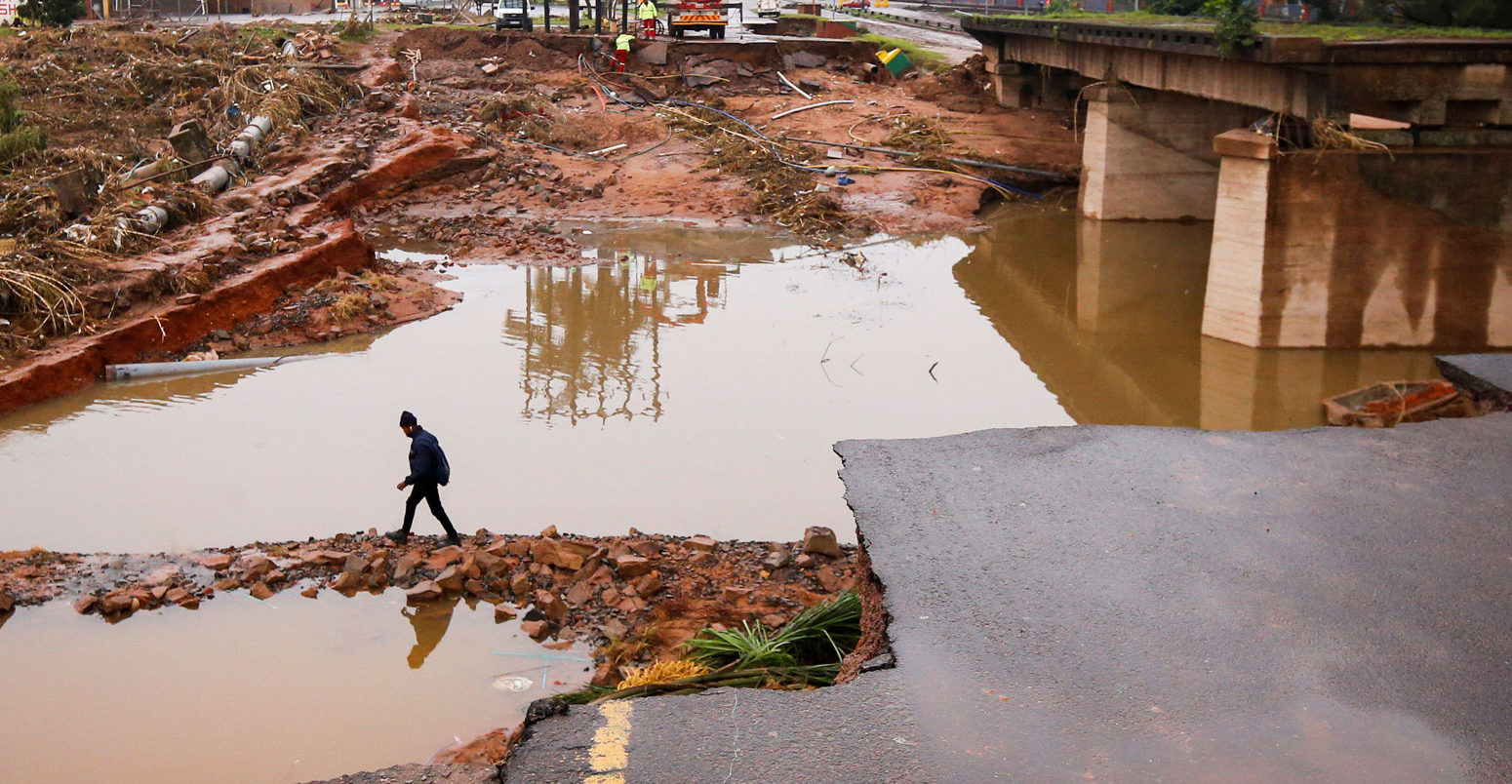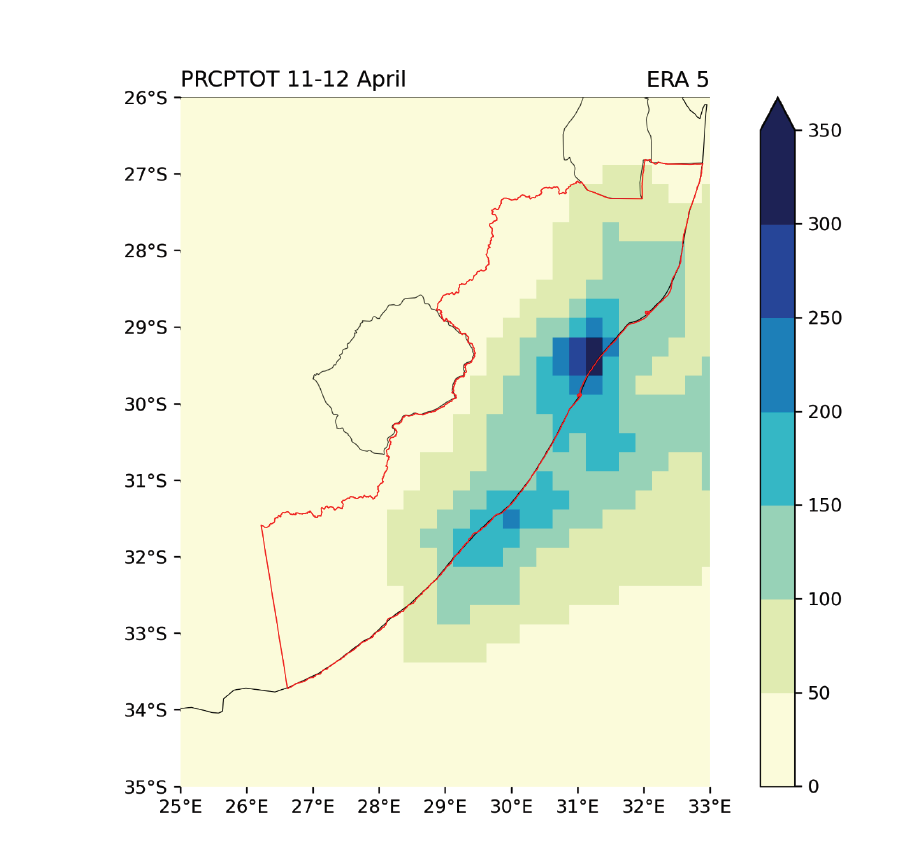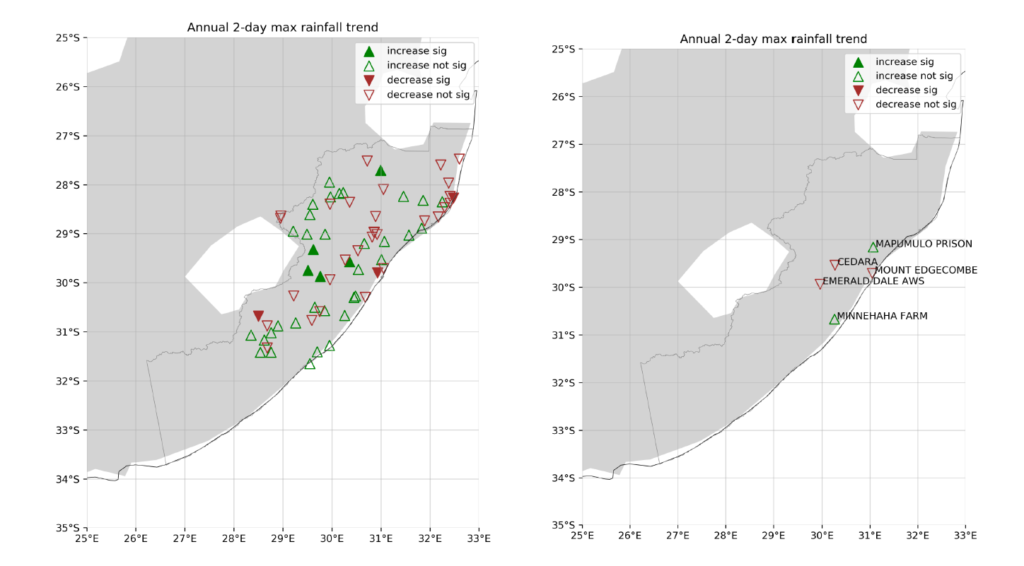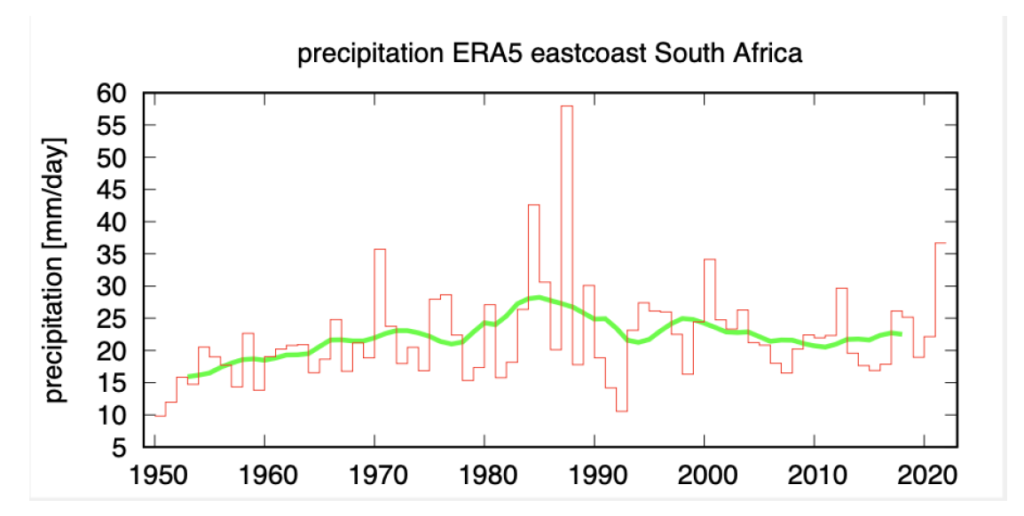
Climate change made extreme rains in 2022 South Africa floods ‘twice as likely’
Ayesha Tandon
05.13.22Ayesha Tandon
13.05.2022 | 12:00pmThe extreme rainfall that triggered one of South Africa’s deadliest disasters of this century was made more intense and more likely because of climate change, a new “rapid-attribution” study finds.
Over 11-12 April 2022, intense rains hit the eastern coast of South Africa – causing floods and landslides across the provinces of KwaZulu-Natal and the Eastern Cape. More than 400 people died as a result of the floods, which also destroyed more than 12,000 houses and forced an estimated 40,000 people from their homes.
The World Weather Attribution service finds that climate change doubled the likelihood of the event – from an event expected once every 40 years to once every 20. It adds that rainfall over the two-day period was 4-8% more intense than it would have been without climate change.
The study also explores the role of structural inequality in vulnerability to flooding, noting that forced relocation moved marginalised groups of people onto land that was more prone to flooding.
“In South Africa, the legacy of apartheid is really key,” an author on the study told a press briefing, adding that “even though apartheid was formally dismantled more than 30 years ago, these structural inequalities persist”.
‘Catastrophic’ flooding
Over 11-12 April 2022, close to a year’s worth of rain fell on the eastern coast of South Africa, causing one of the deadliest natural disasters to hit the country in the 21st century.
In the provinces of KwaZulu-Natal and the Eastern Cape, the deluge triggered “catastrophic” floods and sudden landslides that “devastated” the region. More than 12,000 houses were destroyed, forcing an estimated 40,000 people from their homes.
Meanwhile, 630 schools were affected in the KwaZulu-Natal province, impacting around 270,000 students. Overall, the rain drove $1.57bn in damages to infrastructure.
The South African military deployed 10,000 troops to help search the wreckage for survivors, the death toll quickly rose into the hundreds.
Authorities say that the city of Durban was the most severely affected, with an estimated 450 people killed in the city. In the Port of Durban – one of the largest shipping terminals in Africa – “dozens of heavy shipping containers were dislodged from storage and strewn across the Indian Ocean port during the deluge”.
South Africa’s president, Cyril Ramaphosa, called the floods a “catastrophe of enormous proportions,” and “the biggest tragedy we have ever seen”. He declared a national state of disaster on 18 April. BBC News reported at the time:
“On a visit to affected areas in KwaZulu-Natal, the president said climate change was to blame, but some communities disagree. They say poor drainage and building standards have increased the scale of the disaster.”
The timing of the flood made it particularly damaging because South Africa was still recovering from a string of storms and cyclones. “The new disaster comes after three tropical cyclones and two tropical storms hit south-east Africa in just six weeks in the first months of this year,” the Guardian reported.
Extreme rainfall
The intense rainfall was caused by a “cut-off low” – a mid-latitude depression, where air of polar origin is cut off from the main subpolar belt of low pressure and cold air. This type of weather system is common in South Africa in April, according to the study – and results in heavy rainfall around one-fifth of the time.
On 7 April, the South African Weather Service issued a warning for disruptive rainfall. And as the storm drew closer, the severity of the warning level was raised. However, the study says “the warnings had limited reach and that the people who did receive them may not have known what to do based on them”.
The rainfall began on 9 April, and reached its peak intensity a few days later. In this study, the authors analyse the impact of climate change on maximum two-day rainfall over 11-12 April.
The map below shows the total rainfall on the eastern coast of South Africa over 11-12 April, where darker blues indicate more intense rainfall. The red outline indicates the area analysed in the study.

The South African Weather Service gave the World Weather Attribution team daily rainfall observations for 194 stations in the affected region. According to the study, 70 of the stations had a continuous string of data over 1950-2022 and five were able to provide the required data required in time for the study.
These stations and recorded rainfall trends are shown in the maps below. Green arrows indicate a trend of increasing rainfall over 1950-2022, while red arrows indicate a decrease. The map on the left shows the 70 stations with suitable data. The map on the right shows the 5 stations selected for the study.

Taking an average over the entire area studied, the rainfall over 11-12 April was a 1-in-20 event overall. However, the rainfall varied highly between different weather stations.
“The rainfall was very high in very small locations,” Dr Frederieke Otto – senior lecturer in climate science at the Grantham Institute for Climate Change and the Environment at Imperial College London and co-author of the study – told the press briefing, adding that “there were a few locations where at raised more than 350mm over two days”.
For example, due to high rainfall at the Mount Edgecombe and Mapumulo Prison weather stations, the authors calculated return periods of 1-in-200 years and 1-in-30 years for these stations, respectively.
Otto added that “there is a lag between the data being measured and being made available for people to analyse – that is why we can only use these five [stations].”
Vanetia Phakula – a meteorologist at the South African Weather Service – added that compared to other regions in Africa, South Africa has reasonably good data. However, she noted that many stations in South Africa have been forced to close due to lack of funding.
Attribution
Attribution is a fast-growing field of climate science that aims to identify the “fingerprint” of climate change on extreme-weather events, such as heatwaves and floods. In this study, the authors investigate the impact of climate change on rainfall in South Africa over the 11-12 April period.
To conduct attribution studies, scientists use models to compare the world as it is to a “counterfactual” world without human-caused climate change. This study aims to distinguish the “signal” of climate change in South Africa’s rainfall from natural variability.
The plot below shows a time series of annual maxima of two-day average rainfall over the east coast of South Africa, based on the ERA5 reanalysis dataset, which combines observed data with model simulations. The green line shows a 10-year running average.

The authors conclude that the extreme rainfall was made twice as likely due to climate change – increasing from a 1-in-40 to a 1-in-20 year event. They also find that the event was made 4-8% more intense due to climate change.
(The findings are yet to be published in a peer-reviewed journal. However, the methods used in the analysis have been published in previous attribution studies.)
“We have quite high confidence in the results that we have for this study,” Otto told Carbon Brief at the press briefing.
The authors conclude that the event was “not unprecedented”, and that additional factors played a role in “making this meteorological event so impactful and worth studying”.
‘Legacy of apartheid’
Kwazulu-Natal is the second-most populous province in South Africa with about 11.5 million people. However, the study notes that not all people were impacted equally by the flood. Poorer and more marginalised communities, such as migrants, were disproportionately vulnerable.
For example, in its coverage of the flooding at the time, the Guardian notes that people living in makeshift settlements were particularly vulnerable to the flooding:
“Poor people living in makeshift settlements built on unstable, steep-sided gorges around Durban were worst affected by the floods. Most have inadequate or no drainage systems and homes are sometimes flimsy shacks that offer little protection against the elements.”
Dr Christopher Jack – deputy director of the Climate System Analysis Group at the University of Cape Town, and science advisor Red Cross Climate Centre – told the press conference that flooding and landslides are a “chronic problem” in South Africa.
When considering vulnerability in South Africa, “the legacy of apartheid is really key”, he explained, adding that the “forced relocation of people” led to deep structural inequalities.
For example, the study highlights the Group Areas Act of 1958 – in which the Durban City Council assigned racial groups to different residential and business sections – resulting in “the displacement of many non-white communities into less desirable and, in some cases, more flood exposed areas”.
Jack adds:
“Even though apartheid was formally dismantled more than 30 years ago, these structural inequalities persist, and we still see them represented in our city structures. And we still see them manifest and magnified when events such as this occur.”
-
Climate change made extreme rains in 2022 South Africa floods ‘twice as likely’

